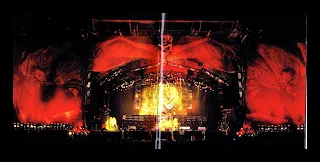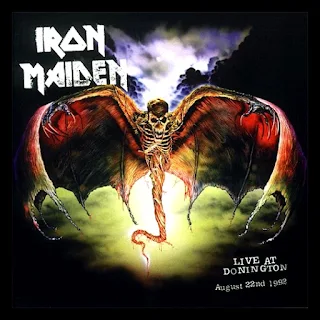1990–1999: Crises and comebacks
The
following year was the tenth anniversary of the release of the debut
album, and it was celebrated on a grand scale, including: The ten-CD box
The First Ten Years Up The Irons was released, containing recordings from twenty subsequent maxi-singles, supplemented with statements by Nicko McBrain
bringing back memories from individual years of their career.
The double maxi-single, released separately, was in the Top 10 of the weekly bestseller charts in Great Britain between February and April 1990. The formation also summarized its audio-visual achievements by releasing an identically titled video cassette with a cross-section of all promotional videos.
In 1990, the musicians also decided to record another studio album. It was supposed to refer in sound and atmosphere to the first albums from Di'Anno era of 1980–1981.
The double maxi-single, released separately, was in the Top 10 of the weekly bestseller charts in Great Britain between February and April 1990. The formation also summarized its audio-visual achievements by releasing an identically titled video cassette with a cross-section of all promotional videos.
In 1990, the musicians also decided to record another studio album. It was supposed to refer in sound and atmosphere to the first albums from Di'Anno era of 1980–1981.
During the recording of the album, Adrian Smith was removed from the group due to artistic differences . His successor was Janick Gers, known for his cooperation with Ian Gillan, White Spirit and for his participation in the recording of Bruce Dickinson's debut solo album, Tattooed Millionaire. This line-up recorded the album No Prayer for the Dying. The album was significantly different from its predecessor. The album
was recorded, not as previously done in renowned studios, but using a
portable Rolling Stone Mobile studio, used in the 1970s by The Rolling Stones, installed in a specially adapted outbuilding on the estate of the
band's leader, Harris.
The changes included both the sound - the
melodies became more raw, and the lyrics - they had a clear political
overtone. The album was promoted by two singles, "Holy Smoke" (number 3 in the UK) and "Bring Your Daughter... To The Slaughter" - the group's first number one single in the UK, where it topped the charts for two weeks. Thus, Iron Maiden set further records in Great Britain: six singles
in the Top 5 bestsellers, 10 double maxi-singles in the Top 10, the
highest position in history for a single debuting on the charts released
by a rock band, the highest number of albums in the Top 10 bestsellers
for an British artists, excluding The Rolling Stones, The Beatles and
Queen, 20 consecutively released singles on the bestseller lists. In addition, Bruce Dickinson, as a composer, received the Golden Raspberry award and a nomination for the American Music Awards in the "Best Rock Song" category. All this for the original interpretation of the aforementioned "Bring
Your Daughter... To The Slaughter". In 1992, the composition received a
nomination for the Brit Awards in the category "Best British Single".
Iron Maiden embarked on the "No Prayer on the Road 1990/91" tour, during which they gave approximately 120 concerts, both in large arenas and more intimate places. 33 concerts in continental Europe were seen by as many as 530,000
people, and in each of the facilities the group set an
attendance record. The musicians gave up the elaborate setting they were famous for in
the past decade, opting for visual austerity and focusing on the music
itself. Nevertheless, the tour was a great success, marked by sold-out
concerts and headlining performances at prestigious events in France (Bol d'Or), Denmark (for the first time as the star of the Roskilde Festival for 65,000 fans) and Switzerland in the summer of 1991. The band once again attracted over 2 million fans.
The
promoted album did not achieve as much commercial success as many
previous ones - however, it reached position 2 in the UK and 17 on the
American Billboard chart, and by 1992 about 2.5 million copies of the album were sold.
Critics and fans alike assessed the album as clearly weaker and
devoid of ambitious ideas, so well known from previous releases. Many
fans perceived the group's new proposal as a manifestation of an
artistic and creative crisis.
By the end of 1991, the band had already sold 31 million albums and
had the status of a legend of the genre and probably the most
influential heavy rock band debuting at the turn of the 1970s and 1980s.
20th century.
The situation was improved by the next album, Fear of the Dark, which debuted at number one on the British charts and ultimately took a high 8th place on the American Billboard chart. The album was recorded in a private studio owned by Steve Harris (called Barnyard Studios) with the final participation of Martin Birch. The hits from the album were the songs "Fear of the Dark", the thrash metal closer "Be Quick or Be Dead" (pilot single, 2nd number on the British charts), the hit single "From Here to Eternity" and the atmospheric, epic "Afraid To Shoot Strangers" and the ballad "Wasting Love", also released as a single. The album sold the best in years, helping to regain the group's former reputation. By May 1993, the album had over 3 million buyers. Following the wave of success, a compilation of music videos entitled From There To Eternity also appeared, prepared with American audiences in mind.
The "Fear Of The Dark Tour 1992" and its sequel "Real Live Tour 1993" were very much a return to the visual splendor of the previous decade, traversing five continents and ultimately culminating in 114 shows seen by an estimated 4.2 million people (including special event attendees and PPV subscribers). Iron Maiden went on a long tour around South America for the first time, performing in local stadiums, including the Ginásio do Maracanãzinho
complex. In Europe, the band played a series of concerts in Germany,
Great Britain, Italy, Spain, and France as the star of the traveling Monsters Of Rock Festival. They performed for the second time at Donington Park in front of approximately 80,000 people. In 1993, they continued their concert march across the Old Continent,
giving a short recital at the non-ticketed Italian MAYDAY Festival
1993, held at San Giovanni In Laterano Square, which attracts over a million people every year. The tour ended with three concerts at the Olympic Stadium in Moscow, with a total capacity of 45,000 seats.
The world tour was summarized by three concert releases: A Real Live One, A Real Dead One and Live At Donington 1992. The last of the concerts was also released in a visual version. The albums were led by the singles "Fear Of The Dark - Live" and "Hallowed Be Thy Name", the albums were included in the Top 10 most popular singles in the
UK. Meanwhile, interpersonal relations between the members of Iron
Maiden deteriorated dramatically. After the tour, Bruce Dickinson left the group due to a different artistic vision. Two staged concerts were organized especially for the fans at London's Pinewood Studios, with the participation of the famous television illusionist Simon
Drake, during which a dark spectacle was presented, filled with scenes
of torture known from gore horror films, culminating with Dickinson's execution during the "Iron Maiden" song.
The show was broadcast by MTV on pay-per-view. In 1994, a video cassette with a recording of the performance was released, titled Raising Hell.
Fans also received a special, limited edition version of the "Maiden
England" video cassette, equipped with a single CD with selected songs
from the concerts in Birmingham. The title track from the album Fear of the Dark
was nominated for an American Grammy music award in the "Best Metal
Performance" category.
At that time, the band had already performed 1,480 concerts for at least 25 million fans, on five continents of the world - which was a record in the history of the metal genre.
At that time, the band had already performed 1,480 concerts for at least 25 million fans, on five continents of the world - which was a record in the history of the metal genre.
















No comments:
Post a Comment